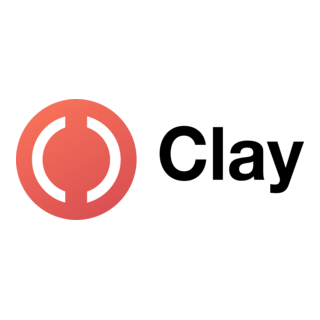
Clay: Complete Buyer's Guide
Hyper-personalization platform for AI lead nurturing
Clay is a hyper-personalization platform that transforms AI lead nurturing through dynamic data synthesis and automated prospect research capabilities. The platform enables marketing and advertising professionals to scale personalized outreach beyond traditional rule-based systems by combining multiple data sources with AI agent technology for comprehensive prospect intelligence[47][59].
Market Position & Maturity
Market Standing
Clay occupies a specialized position in the AI lead nurturing market, competing primarily on data depth rather than breadth of marketing capabilities. This positioning makes Clay complementary to, rather than competitive with, comprehensive marketing platforms for many organizations[44][52].
Company Maturity
Company maturity indicators suggest Clay has achieved operational stability with established customer adoption patterns. The 30% daily usage rate for Claygent demonstrates product-market fit within its specialized niche, while the platform's credit-based pricing model indicates sustainable revenue generation[49][54].
Growth Trajectory
Growth trajectory evidence appears in Clay's expanding feature set and integration capabilities. The platform's Pro plan offering native CRM integrations represents product evolution toward enterprise requirements, while the no-code workflow builder indicates investment in user accessibility[44][48][58].
Industry Recognition
Industry recognition emerges through competitive analysis positioning Clay as a viable alternative to established players. Research comparing Clay to Databar.ai notes Clay's superior workflow customization despite requiring more technical setup, indicating market acknowledgment of the platform's capabilities[57].
Strategic Partnerships
Strategic partnerships with data providers including ZoomInfo and People Data Labs demonstrate ecosystem integration and vendor relationship maturity[59][45].
Longevity Assessment
Longevity assessment suggests Clay's specialized positioning provides competitive protection through technical differentiation. The platform's focus on data intelligence rather than broad marketing automation creates a defensible market niche, though this specialization may limit total addressable market compared to comprehensive platforms.
Proof of Capabilities
Customer Evidence
Clay demonstrates effectiveness through quantified customer adoption metrics, with 30% of users deploying Claygent daily for automated prospect research, indicating strong product-market fit within its specialized niche[49][54].
Quantified Outcomes
Performance validation emerges through documented efficiency gains, with organizations implementing AI lead nurturing solutions like Clay reporting up to 80% reduction in lead qualification time and 25-40% higher conversion rates than manual processes[2][8][12].
Case Study Analysis
Customer success patterns reveal specific implementation approaches that drive results. Organizations achieving optimal outcomes typically follow structured deployment beginning with data quality preparation and phased rollouts focusing on single nurture streams before scaling to comprehensive implementation[48][58].
Market Validation
Market validation appears through competitive positioning analysis, where Clay's dynamic data approach enables real-time prospect intelligence gathering compared to competitors like Apollo's static database model[60][59].
Competitive Wins
Research comparing Clay to alternatives like Databar.ai notes Clay's superior workflow customization capabilities, though requiring more technical setup investment[57].
AI Technology
Clay's technical foundation centers on AI agent technology through Claygent, which performs automated prospect research by analyzing web content, PDFs, and multiple data sources with minimal manual intervention[49][53].
Architecture
The platform's architecture combines first-party data with external sources including ZoomInfo and People Data Labs to create comprehensive prospect profiles that exceed static database limitations[59][45].
Primary Competitors
Clay competes directly with Apollo's database approach, HubSpot's conversational AI workflows, and specialized tools like Databar.ai for data enrichment and lead nurturing capabilities[60][59][44][52][57].
Competitive Advantages
Clay's dynamic data synthesis approach enables real-time prospect intelligence gathering compared to competitors like Apollo that rely on static databases[60][59]. The platform's Claygent AI research agent provides automated prospect research capabilities that exceed traditional rule-based systems, while the no-code workflow builder enables sophisticated campaign creation without technical programming requirements[49][53][58][50].
Market Positioning
Clay occupies a specialized position competing primarily on data depth rather than breadth of marketing capabilities, making it complementary to, rather than competitive with, comprehensive marketing platforms for many organizations[44][52].
Win/Loss Scenarios
Organizations should choose Clay when data enrichment depth and research automation represent primary requirements, particularly for Account-Based Marketing initiatives requiring extensive prospect intelligence[47][59]. Alternative platforms like HubSpot better serve organizations prioritizing conversational engagement and broader marketing automation capabilities beyond lead nurturing specialization[44][52].
Key Features

Pros & Cons
Use Cases
Integrations
Pricing
Featured In Articles
Comprehensive analysis of AI Lead Nurturing for AI Marketing & Advertising for AI Marketing & Advertising professionals. Expert evaluation of features, pricing, and implementation.
How We Researched This Guide
About This Guide: This comprehensive analysis is based on extensive competitive intelligence and real-world implementation data from leading AI vendors. StayModern updates this guide quarterly to reflect market developments and vendor performance changes.
60+ verified sources per analysis including official documentation, customer reviews, analyst reports, and industry publications.
- • Vendor documentation & whitepapers
- • Customer testimonials & case studies
- • Third-party analyst assessments
- • Industry benchmarking reports
Standardized assessment framework across 8 key dimensions for objective comparison.
- • Technology capabilities & architecture
- • Market position & customer evidence
- • Implementation experience & support
- • Pricing value & competitive position
Research is refreshed every 90 days to capture market changes and new vendor capabilities.
- • New product releases & features
- • Market positioning changes
- • Customer feedback integration
- • Competitive landscape shifts
Every claim is source-linked with direct citations to original materials for verification.
- • Clickable citation links
- • Original source attribution
- • Date stamps for currency
- • Quality score validation
Analysis follows systematic research protocols with consistent evaluation frameworks.
- • Standardized assessment criteria
- • Multi-source verification process
- • Consistent evaluation methodology
- • Quality assurance protocols
Buyer-focused analysis with transparent methodology and factual accuracy commitment.
- • Objective comparative analysis
- • Transparent research methodology
- • Factual accuracy commitment
- • Continuous quality improvement
Quality Commitment: If you find any inaccuracies in our analysis on this page, please contact us at research@staymodern.ai. We're committed to maintaining the highest standards of research integrity and will investigate and correct any issues promptly.